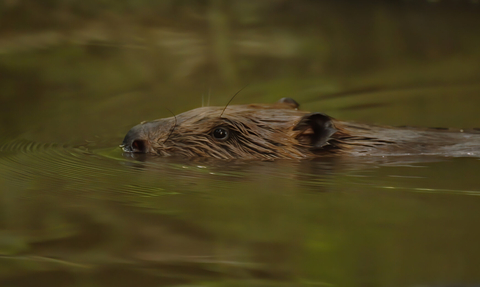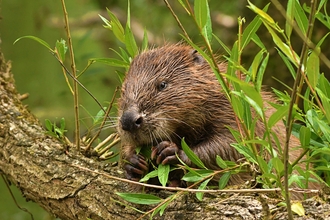
Beaver swimming with its head just above the water © Russell Savory
Dorset Beaver Project
Dorset Beaver Project site video tour
Would you like to take a peek behind the scenes of the Dorset Wildlife Trust beaver project site? Now you can! Dive into their wonderful wetland world in West Dorset, and learn all about these ecosystem engineers with Rivers Conservation Officer, Steve Oliver.
Dorset Beaver Project site video tour (https://youtu.be/MdEJawbJ36A)
Video tour of the Dorset Beaver Project site
Introducing Dorset's newest beaver kits
Over the past three years, kits have been born at Dorset Wildlife Trust's enclosed beaver site in West Dorset. Eagle-eyed Conservation Officers have captured these special images and videos of the two kits after closely monitoring the site throughout spring and summer. Throughout the project, animal welfare is an absolute priority, so we have ensured that the 4-hectare enclosed site offers enough complex habitat to support the newly expanded beaver family.
The newly born kits, born in springtime, spent their first month within the safety of the lodge, an underground chamber and burrow system, before emerging between dusk and dawn in early summer to explore the wetland surroundings with the rest of their family.
Rivers Conservation Officer, Steve Oliver said, "Breeding is a clear indication that the beavers we introduced to site are healthy and happy in their Dorset home. The adult pair originally released back in February 2021 settled in from the word go, building dams and modifying the existing freshwater habitat to suit their needs. The building of a lodge and now the subsequent raising of three sets of kits is really encouraging. Beavers are a keystone species and the complex biodiverse wetlands they create by doing what comes naturally to them, can benefit many other forms of wildlife."
Second generation beaver kit feeding on willow (https://youtu.be/s9DO2Tqtq_Q)
Colleen Smith-Moore / New beaver kit feeding on willow branches in the Dorset Beaver Project site.
Support the Beaver Project
Thank you from the Beaver Project (https://youtu.be/iOykEiQRoQA)
We're very grateful for the support of our members and everyone who donated to the Beaver Project - here's a special thankyou from Project Officer, Steve Oliver.
Beaver kits are born with the ability to swim and normally stay close to their parents as they are very vulnerable to predators when young. For the first two to three weeks, kits feed on their mother's breast milk but within six weeks, they will also be eating leaves, aquatic plants and tree bark of which there is plenty in their enclosure. Beavers are strict herbivores and do not eat fish, a common misconception.
Eurasian beavers were once native to Dorset and are known as nature's ecosystem engineers due to their activities, such as dam building to create deep water in which they feel safe, having such a positive impact on the local environment. Beavers even have the potential to reduce flooding by slowing the rate of water during extreme rainfall events. Once common in the UK, European beavers were hunted to extinction for their fur, glands and meat in the 16th century.
Dorset Beaver Project
Following years of preparation for their arrival, a pair of beavers (an adult male and female) were released into an enclosed site in west Dorset on 8 February 2021, having been relocated from Scotland under licence from NatureScot. The pair have settled well into their new home and it is a privilege to be able to study one of nature’s great engineering species, right here in our county.
Beaver release, Dorset 2021 (https://youtu.be/QniUYCRszHk)
Watch footage of the moment the male beaver was released into the enclosed site. © Dorset Wildlife Trust/James Burland
Dams and the environmental impact of beavers
Beavers are often referred to as 'ecosystem engineers' and can modify the habitats and landscapes they live in through coppicing, feeding and in some cases damming (beavers dam to create deep water and those living on lakes or larger rivers have a lower need to constructing dams). However in many cases when they are living at low density, their impacts can be remarkably subtle and go unnoticed for many years.
They make changes to their habitats, such as digging canal systems, damming water courses, and coppicing tree and shrub species, which create diverse wetlands that benefit both people and wildlife.
- By creating multiple channels in the river and wetland habitats which hold back water, this can help to reduce downstream flooding by releasing it more slowly after heavy rain
- Other species benefit from the expanded wetland habitat, such as otters, water shrews, water voles, birds, invertebrates (especially dragonflies) and breeding fish
- By slowing the flow of the river, siltation is reduced which pollutes the water thereby giving us cleaner water
Beavers and trees
As herbivores, beavers eat a wide range of vegetation and this can include trees. They forage close to water with activity usually concentrated within 20 metres of the water’s edge. Beavers do selectively fell broad-leaved trees and bushes to reach upper branches, to encourage regrowth, to eat the bark during the winter and to construct their lodges and dams. Many tree species regenerate, which diversifies the surrounding habitat structure and create areas of mixed-height, mixed-age vegetation that benefits many wildlife species. Coppicing has been practiced by foresters throughout history as a method to manage bankside trees. The actions of beavers are very similar, meaning woodlands and trees are more naturally managed. Where needed, there are methods to protect special trees from unwanted attention from beavers and we are testing these in our enclosed site.
Beavers and fish
Although they don't eat fish, habitat modification by beavers can affect fish in some circumstances, and anglers are often concerned about the potential impact of beaver dams on the movement of migratory fish. Historically these species will all have been adapted to live together, but our wildlife and rivers have been severely affected by human activity since then and, as nature recovers, any species that is at a low ebb may struggle to cope with change and need a helping hand. The interaction between beaver activity and freshwater fisheries has been the subject of several reviews. Overall the impacts have been found to be positive, the benefits being an increased area and variety of fish habitat, increase in invertebrates and cleaner and more plentiful water. Negative impacts can include the impact of dams on fish movement (though dams are by nature leaky and fish can travel through and up many of them), changes to spawning gravels (cleaner gravels downstream of dams, but more silted upstream) and lower oxygen levels in ponds. We are surveying fish and aquatic invertebrates as part of our enclosed study to show the possible impacts beavers have on other wildlife.
Protection and management of beaver populations
The Government has now announced that beavers will be protected in England. Dorset Wildlife Trust supports this legislation alongside appropriate and proportionate licensing arrangements that enable timely management measures.
It is essential that Government makes funding available for land managers to make space for water, including but not just by beaver activity. Beavers can have many benefits for the wider environment, but there can also be localised costs and problems, and funding should be targeted to help address these. Face-to-face advice and support is essential for landowners and those directly impacted by beaver activity. This has been effective in the River Otter beaver trial in Devon - there is more information about that project if you click on the link below.
Learning from others
Reintroductions and translocations of Eurasian beaver have now taken place in more than 25 European countries, starting in the 1920s, so there are years of experience to draw from. Evidence shows that shows that beaver impacts are, in the vast majority of cases, small-scale and localised. Beavers are not normally regarded as pests in Europe and where localised problems have occurred, there are a number of well-established mitigation methods that can be adopted. These include the removal of dams, the introduction of overflow piping, or the installation of fencing (as one does for deer and rabbits). In some cases, the removal and translocation of beavers could be considered. Some countries with sustainable beaver populations permit seasonal hunting and/or lethal control as legitimate management strategies. In the 'Living With Beavers' film (link below) a group from Cornwall visit Bavaria to hear more about managing beavers there.
How long is the project going to run for?
The project licence was initially for five years (2020-2025) and has been extended for a further five years until 2030, whilst we explore other options such as a licence for wild beaver release.
What’s being studied at the site?
This is a scientific study site and in partnership with the University of Exeter and Wessex Water, we are gathering information on biodiversity and hydrology (water quality and flow) and studying the behaviour and activities of the beavers. We will be making comparisons to the baseline data gathered before they arrived to see how beavers can improve the habitat they occupy and the wider benefits they can potentially bring to the environment in terms of biodiversity, water quality and beneficial effects on river catchments.
Can I visit the Beaver Project site and see the beavers?
The site is a locked site with no parking or public access and will be accessible for accompanied visitors by invitation only. We are sharing footage and photographs of the beavers in our blog and on social media so you can stay up to date with how they are doing.
Did you know? Myth-busting facts
- Beavers are vegetarians. They do not eat fish. In fact, they are known to co-exist well with them, boosting fish populations. Beavers snack on riverside plants, grasses, as well as tree bark and shoots.
- Beavers feel safest in still, deep water (around 70cm). They are very unlikely to stray far from it and will create dams if the water levels aren’t what they would like them to be.
- Where beavers go – more wildlife will follow. Beavers create diverse wetland habitats that can provide a home for a wide range of wildlife such as amphibians, water voles, dragonflies, birds and even plants.
-
Beaver dams vary in size and structure. In many cases they are small temporary structures made of twigs, which gradually break down as water levels rise. In others, they can be larger stable structures that create big ponds. Both water and fish are able to move through and around them and they are not the huge dam structures made by the North American beaver.
-
Beavers can reduce flooding. Beaver dams slow the flow of water; in storms more water is stored; in droughts more water is available. The potential for beavers to reduce flooding and maintain baseflows downstream is significant.
-
Beavers can improve water quality. Impoundment of water behind dams can positively affect the quality of water by diffusing pollutants being transported downstream. Their dams act as sediment traps cleaning our waters.
Online talk: Dorset Beaver Project (https://youtu.be/lBiQMKCi7cU)
Online talk: Dorset Beaver Project. By Steve Oliver, 29.01.25
This isn't just about the reintroduction of a species - it's about the reintroduction of an entire ecosystem that's been lost.
Follow the Beaver Blog for the latest updates on Dorset's beavers
Beaver updates straight to your inbox
Sign up to our regular email newsletter for updates and the latest news about the beavers and the work we do in Dorset to protect wildlife. Stay tuned to our News and Blog pages and this webpage for updates on the beavers and ways you can help.




